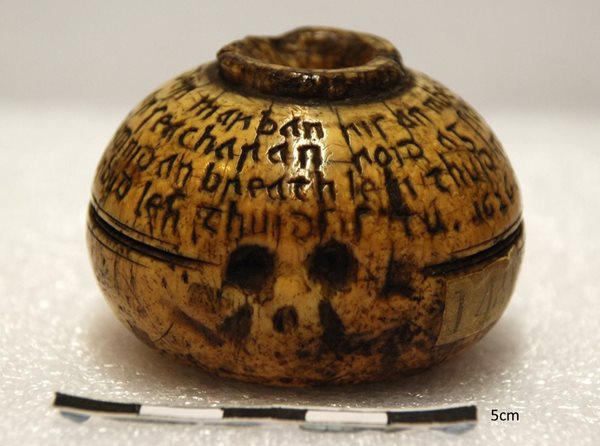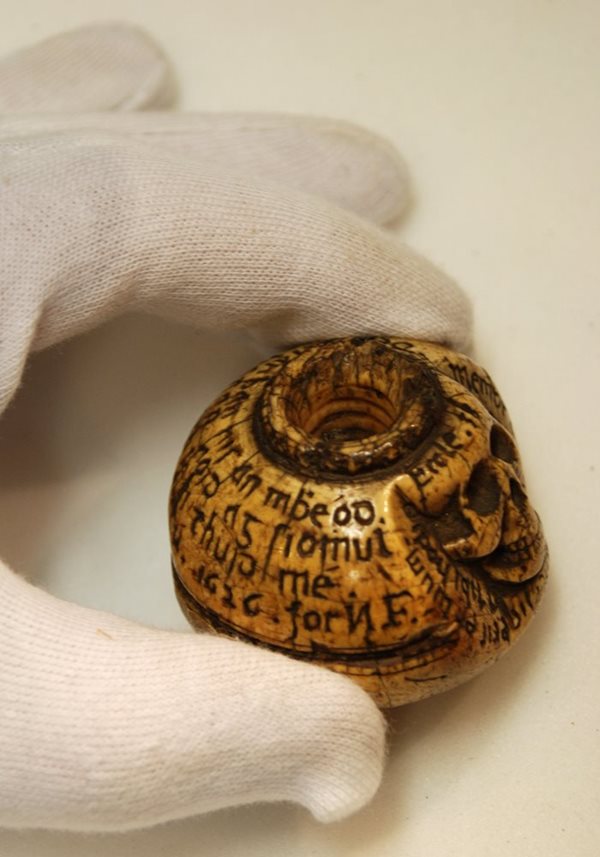17th century
Skulls and Cross Pedestal
Decoding the mysteries of an ivory cross pedestal carved with skulls and biblical inscriptions found in Smerwick Harbour, on the Dingle Peninsula, Co. Kerry.
By Sharon WeadickThis is one of the more intriguing objects in the Museum's Irish Antiquities collection. The object appears to be the pedestal from a two part composite crucifix. Unfortunately, the crucifix element appears to have been long since separated from the pedestal and presumed was lost before the Royal Irish Academy (RIA) purchased the pedestal in 1831. The pedestal is of ivory and features carvings of skulls. The purpose of these was to convey the message that man is mortal and will die one day. Perhaps more intriguingly the object contains two inscriptions, one in Latin and one in Irish.
Register entry
The details for the pedestal in the original RIA registers are scant, recording only the registration numbers (R2969 and W149), object name and that it was purchased. Fortunately the RIA Antiquities committee minutes (vol. 1) records that it was found in Smerwick Harbour in Kerry and acquired by the Academy on October 3rd 1831 from a Mrs. Cecilia Dee.
Description
The ivory pedestal is relatively light and small, measuring 5.80cm in diameter by 3.80cm high. It has a flat, broad base, convex sides and at the top there is socket which would have supported the base of the crucifix shaft. The socket has an extended, straight-sided rim and is cylindrical in shape. Around the circumference of the pedestal there is a series of carved decorative parallel lines dividing the pedestal into upper and lower sections. The Latin inscription encircles the skull at the front and is worn and chipped in places. The Irish inscription covers the upper section to the rear.

The two carved skulls on the pedestal differ markedly in both their appearance and execution. The skull at the front is three-dimensional, detailed, and finely carved. Whereas the skull at the back is more crudely carved, one-dimensional and incomplete - the mouth is missing. It is possible that this skull and some other features are later modifications or additions. For instance, the lowest line of the Irish inscription rises up to avoid the eye sockets of the skull at the back indicating that inscription was added after the skull was carved.
Inscriptions
Carved on the forehead of the front skull, ‘Eccle. 38’, refers to the Old Testament Book of Ecclesiasticus also known as the Wisdom of Sirach. The Latin inscription is taken from Eccl. 38: 22. The inscription is only partly legible.
The inscription in Irish is perhaps more interesting. Rather than translating the Latin text directly the Irish appears more to be an interpretation of the message or meaning it conveys – that we are all destined to die. The Irish also introduces this with something of a poetic preamble not found in the actual biblical text. Furthermore, the Irish inscription also carries the date 1626 and what appears to be a dedication with what appears to be initials NF, the N being reversed. As an interesting sidenote, the date 1626 predates the first official translation of the Old Testament into Irish by William Beddell which he did not begin until the 1630s.‘Eccle. 38
memor es[to iudicii mei sic enim] erit et tuum
mihi h[eri e]t tibi hodie’
‘Remember my judgment: for thine also shall be so:
yesterday for me, and today for thee.’

Like the Latin inscription the Irish is somewhat marked and unclear in places, however the text itself is quite legible.
Deir marban ris an mbeod
Ar seacharan roid ag siomhal
cuimnid an breath ler thuid mé
gurbud ler thuid…is tú 1626. for NF
‘The dead man says to the living (man)
Having lost his way walking
Remember the judgement by which I fell
it is by it you will fall. for NF’
The skulls
On first examination of the pedestal the skulls would appear to be memento mori emblems. Memento mori are symbolic or artistic reminders of our mortality. They are found in funerary art, sculpture and architecture, but also on jewellery and in literature. Some of the earliest examples can be found images on the surviving portions of mosaic floors from Pompeii. Their popularity grew significantly in the later medieval period and continued into the Victorian period. Originally the front skull may have represented the skull of Adam and the pedestal itself Golgotha. Golgotha, which means the place of the skulls, is where Adam’s skull is said to have been buried and Jesus was crucified. In late medieval religious art a skull, supposedly that of Adam, is often depicted at the base of the cross. When the crucifix, now lost, was in place this ivory pedestal may possibly have depicted the same scene.
To conclude
The pedestal is more than deserving of further research – the Irish inscription warrants further examination on linguistic, palaeographic and orthographic grounds. Comparison with other contemporary biblical texts in the vernacular would also be worthwhile. The object currently lacks any context prior to its acquisition by the Royal Irish Academy. Further research may provide some of this missing context. For example, how Cecilia Dee came to be in possession of the object and what relationship, if any, she or it have to Smerwick Harbour could be important elements in this context.
Learn more
This object is currently not on public display is part of the Museum’s reserve collections. The wooden sculpture of Christ in sorrow from Fethard, Co. Tipperary is on display in the “Medieval Ireland” exhibition on the first floor in the National Museum of Ireland – Archaeology on Kildare Street. Also other items from the Documentation Discoveries series are currently on display in the National Museum of Ireland – Archaeology.
References
Hankiss, Elemér 2001 Fears and symbols: An introduction to the study of Western Civilisation. Central European University Press Budapest.
McCaughey, Terence 2001 Dr Bedell and Mr. King: The making of the Irish bible. Dublin Institute of Advance Studies.
Further reading
Ryan, Salvador 2007 ‘Weapons of Redemption: piety, poetry and the Instruments of the Passion in late medieval Ireland’ in Henning Laugerud and Laura Skinnebach (eds), Instruments of Devotion: the practices and objects of religious piety from the late Middle Ages to the 20th century. Aarhus: Aarhus University Press.
With thanks to Muiris Ó Raghallaigh for translating the Irish inscription and assistance with this section of the article, Maeve Sikora, curator of the early medieval collections and Raghnall Ó Floinn, Director of the National Museum of Ireland.
Suíomh:
Skulls and Cross Pedestal suite ag:
In Storage
An déantán roimhe seo:
Set of Religious Postcards by Richard King
An chéad déantán eile:
